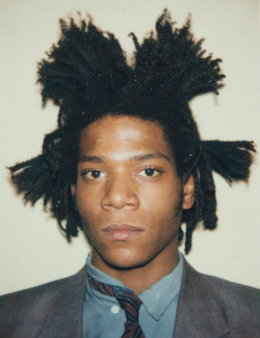
Jean-Michel Basquiat was an American artist who rose to success during the 1980s as part of the Neo-expressionism movement.

Fred Brathwaite, more popularly known as Fab 5 Freddy, is an American visual artist, filmmaker, and hip hop pioneer. He is considered one of the architects of the street art movement. Freddy emerged in New York's downtown underground creative scene in the late 1970s as a graffiti artist. He was the bridge between the burgeoning uptown rap scene and the downtown No Wave art scene. He was immortalized in 1981 when Debbie Harry rapped on the Blondie song "Rapture" that "Fab 5 Freddy told me everybody's fly." In the late 1980s, Freddy became the first host of the groundbreaking hip-hop music video show Yo! MTV Raps.

Leonard Hilton McGurr, known as Futura, and formerly known as Futura 2000, is an American graffiti artist.

Downtown 81 is a 2000 American film that was shot in 1980-1981. The film was directed by Edo Bertoglio and written and produced by Glenn O'Brien and Patrick Montgomery, with post-production in 1999-2000 by Glenn O'Brien and Maripol. It is a rare real-life snapshot of an ultra-hip subculture of post-punk era Manhattan. Starring renowned artist Jean-Michel Basquiat and featuring such East Village artists as James Chance, Amos Poe, Walter Steding, Tav Falco and Elliott Murphy, the film is a bizarre elliptical urban fairy tale. In 1999, Michael Zilkha, founder of ZE Records, became the film's executive producer.
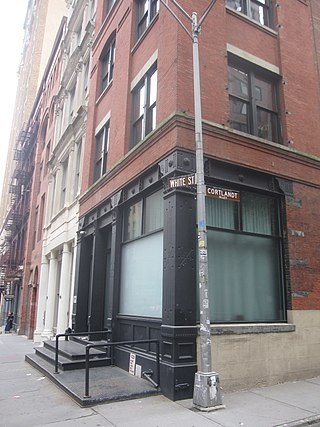
The Mudd Club was a nightclub located at 77 White Street in the TriBeCa neighborhood of Lower Manhattan in New York City. It operated from 1978 to 1983 as a venue for post punk underground music and no wave counterculture events. It was opened by Steve Maas, Diego Cortez and Anya Phillips.
Rammellzee was a visual artist, gothic futurist "graffiti writer", painter, performance artist, art theoretician, sculptor and a hip hop musician from New York City, who has been cited as "instrumental in introducing elements of the avant-garde into hip-hop culture".
George Lee Quiñones is a Puerto Rican artist and actor. Quiñones rose to prominence by creating massive New York City subway car graffiti that carried his moniker "LEE". His style is rooted in popular culture and often with political messages.
Edo Bertoglio is a Swiss photographer, film director and screenwriter. He is the director of Downtown 81 and Face Addict.
Patti Astor is an American performer who was a key actress in New York City underground films of the 1970s, and the East Village art scene of the 1980s, and involved in the early popularizing of hip hop. She co-founded the instrumental contemporary art gallery, Fun Gallery.
SAMO is a graffiti tag originally used on the streets of New York City from 1978 to 1980. The tag, written with a copyright symbol as "SAMO©", and pronounced Same-Oh, is primarily associated with the artist Jean-Michel Basquiat, but was originally developed as a collaboration between Basquiat and Al Diaz.

"Beat Bop" is a song by American hip-hop artists Rammellzee and K-Rob. It was produced and arranged by Jean-Michel Basquiat. Initially, it was made as a test pressing by Tartown Inc. in 1983. That same year, the song was released as a single by Profile Records, and featured in the hip-hop documentary film Style Wars (1983).

Jean-Michel Basquiat: The Radiant Child is a 2010 documentary film directed by Tamra Davis. It crosscuts excerpts from Davis' on-camera interview with the artist Jean-Michel Basquiat and anecdotes from his friends and associates. The film was shown at the Sundance Film Festival in 2010.
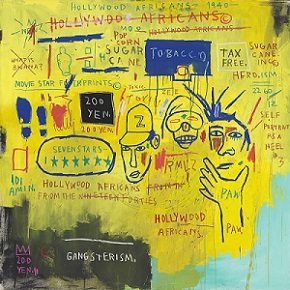
Hollywood Africans is a painting created by American artist Jean-Michel Basquiat in 1983. The artwork is Basquiat's response to the portrayals of African Americans in the entertainment industry.
Gray is an American experimental band formed by artist Jean-Michel Basquiat and filmmaker Michael Holman in 1979, of whom filmmaker Vincent Gallo was also a member. The group was influenced by the members' artist backgrounds and the sonic experimentation of their contemporaries in New York's No Wave scene. Gray performed at venues such as the Mudd Club and CBGB which were the epicenter of New York's underground scene in the late 1970s and early 1980s.
The Fun Gallery was an art gallery founded by Patti Astor and Bill Stelling in 1981. The Fun Gallery had a cultural impact until it closed in 1985. As the first art gallery in Manhattan's East Village, it exposed New York to the talents of street art by showcasing graffiti artists like Fab 5 Freddy, Futura 2000, Lee Quiñones, Zephyr, Dondi, Lady Pink, and ERO. Contemporary artists Kenny Scharf, Jean-Michel Basquiat, and Keith Haring also had solo exhibitions at the Fun Gallery.
Torrick Ablack, also known as Toxic, is an American artist who was part of the graffiti movement of the early 1980s in New York City. He transitioned from street art to exhibiting his paintings in galleries and museums internationally.
Anthony Clark, known as A-One, was an American graffiti artist. He developed a style he called "aerosol expressionism".
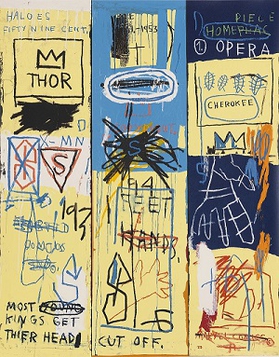
Charles the First is a painting created by American artist Jean-Michel Basquiat in 1982. The artwork is a tribute to jazz musician Charlie Parker, and it was the basis for rapper Jay-Z's 2010 song "Most Kingz."
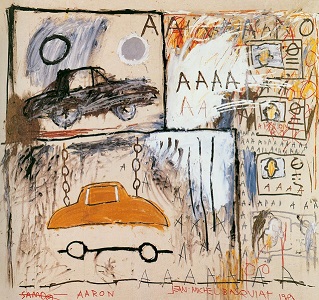
Cadillac Moon is a painting created by American artist Jean-Michel Basquiat in 1981. It is notable for being the first purchased Basquiat painting; bought by singer Debbie Harry for $200.

Bird on Money is a 1981 painting created by American artist Jean-Michel Basquiat in 1981. It is a tribute to jazz musician Charlie Parker, who was nicknamed "Bird." The painting was acquired in 1981 and is housed in the Rubell Family Collection. In 2020, New York rock band the Strokes used the artwork as the cover for their studio album The New Abnormal.










